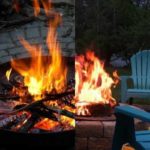As someone who has had firepits at nearly every residence I’ve owned, I try to buy or find the best kind of firewood for those cool fall and winter nights when the family wants to enjoy the warmth of a firepit. But is there a single type of wood that works best for an outdoor fire pit?
The best wood for heating and burning outdoors is Oak, because it produces the highest heat and burns longest. Oak is also plentiful and is considered renewable. Birch is a close 2nd.
I will explain how to measure the heat value of wood, what the best wood for heating outdoors is, and which woods to avoid completely.

What to Consider When Buying Firewood for Heating
Whether you buy a truckload of firewood or just pay for the small stacks at the local store, wood costs money. So it stands to reason that you’d want to get the firewood that produced the most heat. There are scientific measurements that many people don’t realize exist.
You want to choose a wood that has a high heat value. Heat value is measured in British Thermal Units (BTU). The higher your BTU per weight (pound or kilograms), the more energy is released. The higher the heat value, the longer your wood will stay lit and the more heat it will produce.
That leads me to burn rate – you want to choose a wood that has a long burn rate. That way you can be sure to have enough kindling to keep pushing the embers and flames to burn the wood you are using. The burn rate is the amount of fuel mass that is consumed per unit of time in the course of combustion.
Softwood burns fast but has a lower heat value than hardwood. It also gives off a lot more smoke, which can be annoying. It can also leave behind resin inside chimneys, and that is a fire hazard. Hardwoods that are dry burn longer and produce more heat than softwood.
No matter which wood you use, remember that you need to season it to get the best burns. That means cutting it up, splitting it, and stacking it so that the sun can warm it, getting rid of excess moisture. Usually, if you purchase your wood in a small strap from a local store, it has already been seasoned.
Quick Comparisons of Heat Value for Commonly Used Wood
| Wood Type | Heat Value | Hard or Soft Wood? |
|---|---|---|
| Hickory | 28.5M BTU | H |
| Ash | 20.0M BTU | H |
| Birch | 20.8M BTU | H |
| Maple | 25.5M BTU | H |
| Oak | 29.1M BTU | H |
| Pine | 16.2M BTU | S |
| Fir | 14.6M BTU | S |
| Spruce | 15.5M BTU | S |
What Is the Best Firewood for Heating?
Hickory
In my opinion, hickory is the best type of firewood for several reasons. For one, it has a very high heat value, which means it will heat up an area a lot quicker than most other wood. It also burns slightly slower than most hardwoods. Hickory has a very pleasant smell. This is the kind of wood that people love to use when cooking meat because the smell seeps into the flavor of the meat.
Hickory also produces less ash than a lot of other wood. This means the clean-up will be easier. It may be a bit more expensive and difficult to find because it’s used so often. I just feel that if you can find hickory for your fires, especially when you’re cooking, it may be worth the extra cost and drive.
Oak
These trees are quite plentiful and grow easily, so they can be used and more grown. This is the most common wood to find for burning. It burns slowly, so it may take a while before you need to add more wood to the fire. It also produces less smoke than most other wood.
Birch
Birch is even easier to find than oak. It’s actually one of the most common trees available in both North America and Europe. It’s a quick grower and it is plentiful. This is usually the kind of firewood I get when I just need fire pit wood.
Even though birch burns hot, this type of wood has a high sap content, so it contains a lot of water. It will burn a very long time compared to other hardwoods and will not create a lot of smoke or ash. The birch can actually be tapped to make a syrup that is darker and contains less sugar than maple but is still quite usable.
Maple
Maple has a low density compared to oak or hickory. It splits easily and has a lovely scent that’s a bit lighter than hickory. It can provide fires with a long burn so long as it has been seasoned well.
If you want to know which maple is best for firewood, look to sugar maple. This wood produces fewer sparks and gives off less smoke. But you really need to realize that there can be a major difference in the type of maple you get. Hard maple is good firewood while soft maple tends to have similar burn issues as any other softwood.
What Wood Should You Not Burn?
Almost every kind of wood can be used for heating outdoors, but that doesn’t mean it should be used. There are several types of wood that aren’t great for burning. It may be all you have, and that’s understandable – if you’re using it in an open flame and not in a chiminea or outdoor oven with a chimney, there should be no worries.
Pine
Using it outdoors is fine, but try not to use it in a chimney – it gives off resin and can coat a chimney in the substance that some called creosote. This is a fire hazard. I remember my mother using it and the fire department had to be called because the resin backed up the smoke into the house and actually caused a flame at the top of the chimney.
This resinous sap is precisely what makes it such a good firestarter. It can get your fire started very quickly. Also, something relatively new has been found from studies of so many wildfires and forest fires. Burning pine gives off a chemical that may be harmful. So if you do burn it outdoors, use it only for kindling or mix it with other wood.
Fir
If you’re going to use a conifer for firewood, fir might be the best. It does not heat up fast, but it does burn easily and it doesn’t produce a lot of ash. However, keep in mind that as the wood burns it will spark a lot. Be very careful of those sparks popping into the air and causing subsequent small fires in the dry season. Sometimes softwoods like Douglas fir are all you have around.
Spruce
Spruce isn’t fantastic for burning as firewood outside because of the low heat value and quick burn time. Like pine it will produce a lot of creosote/resin coating inside of a chimney, so be aware of that.
In Conclusion
Hopefully, this article gives you somewhere to start when looking for the right kind of wood to use in your outdoor fires, whether that’s in a fire pit or a wood-burning oven or stove. Enjoy and if you have any more questions, feel free to contact us.













